Artículo
Contribution of carbonate precipitation to the preservation of ripples in siliciclastic sediments colonized by microorganisms
Maisano, Lucia ; Quijada, Isabel Emma; Perillo, Vanesa Liliana
; Quijada, Isabel Emma; Perillo, Vanesa Liliana ; Cuadrado, Diana Graciela
; Cuadrado, Diana Graciela ; Raniolo, Luis Ariel
; Raniolo, Luis Ariel ; Gomez, Eduardo Alberto
; Gomez, Eduardo Alberto
 ; Quijada, Isabel Emma; Perillo, Vanesa Liliana
; Quijada, Isabel Emma; Perillo, Vanesa Liliana ; Cuadrado, Diana Graciela
; Cuadrado, Diana Graciela ; Raniolo, Luis Ariel
; Raniolo, Luis Ariel ; Gomez, Eduardo Alberto
; Gomez, Eduardo Alberto
Fecha de publicación:
15/12/2021
Editorial:
Asociación Argentina de Sedimentología
Revista:
Latin American Journal of Sedimentology and Basin Analysis
ISSN:
1669-7316
e-ISSN:
1851-4979
Idioma:
Inglés
Tipo de recurso:
Artículo publicado
Clasificación temática:
Resumen
The present study documents the biostabilization and early lithification of ripple marks created during high-energy hydrodynamic events in a coastal environment colonized by microbial mats. The presence of microorganisms and their characteristic secretion of exopolymeric substances (EPS) are biological factors that diminish the sediment permeability, a first step to maintain seawater over the sediment. Subsequently, seawater is evaporated causing an increase in salinity that leads to the precipitation of calcite and gypsum. The calcite precipitation covering the microbial mat and ripple marks is documented in detail. The study was conducted in Paso Seco (40°38’40’’S; 62°12’22’’W), a modern coastal flat within an elongated semi-closed basin colonized by microbial mats frequently inundated. Salinity was measured in different ponds in the flat with different degrees of evaporation, and in a tidal creek. Water samples were analysed to determine Ca2+, CO3 2- and SO4 2- concentrations. Seawater level fluctuations relative to the tidal flat were measured through a 10-month period in 2018 using a HOBO water level logger. Ripple field formation over the tidal flat was documented after the occurrence of a severe storm and was monitored throughout three field trips. Six months after the formation of the ripples, a sedimentary block containing their vertical section was taken to perform petrographic studies. A laterally continuous dense micritic calcite layer, 100–200 µm in thickness, was identified covering ripple structures, improving the immobilization of these bedforms, and promoting their early lithification. Our observations of modern sedimentary structures and the in situ study of their evolution and early lithification may be potentially useful to be taken into account for the interpretation of similar sedimentary structures in the geological record.
Archivos asociados
Licencia
Identificadores
Colecciones
Articulos(IADO)
Articulos de INST.ARG.DE OCEANOGRAFIA (I)
Articulos de INST.ARG.DE OCEANOGRAFIA (I)
Citación
Maisano, Lucia; Quijada, Isabel Emma; Perillo, Vanesa Liliana; Cuadrado, Diana Graciela; Raniolo, Luis Ariel; et al.; Contribution of carbonate precipitation to the preservation of ripples in siliciclastic sediments colonized by microorganisms; Asociación Argentina de Sedimentología; Latin American Journal of Sedimentology and Basin Analysis; 28; 2; 15-12-2021; 119-130
Compartir



